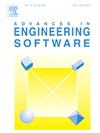Size-dependent topology optimization for eigenfrequency maximization of microplates using consistent couple stress theory
IF 5.7
2区 工程技术
Q2 COMPUTER SCIENCE, INTERDISCIPLINARY APPLICATIONS
引用次数: 0
Abstract
This paper aims to maximize the fundamental eigenfrequency of the Mindlin microplate using the topology optimization approach and consistent couple stress theory (C![]() CST). The modified bound formulation and the modified solid isotropic material with penalization (SIMP) approach are implemented to circumvent some undesired issues including repeated eigenfrequencies and localized mode. A four-node finite element with 80 degrees of freedom is used to meet the C
CST). The modified bound formulation and the modified solid isotropic material with penalization (SIMP) approach are implemented to circumvent some undesired issues including repeated eigenfrequencies and localized mode. A four-node finite element with 80 degrees of freedom is used to meet the C![]() CST-based C1 continuity requirements, which reduces to 48 degrees of freedom when stretching deformation is neglected. The generalized optimality criteria method (G-OCM) is adopted to update the design variables. Subsequently, undesired frequency bands are removed by using a continuously differentiable frequency band constraint (FBC). The optimal topology for in-plane and out-of-plane vibration as well as their coupling mode are presented. Also, the optimal distribution of the nano-reinforcement phase to maximize the eigenfrequency of the nanocomposite microplate is determined. To achieve this, the reinforcement-phase element volume fraction and a special unified homogenization function, instead of SIMP, are considered for the design variable and material properties interpolation scheme, respectively. The small-scale effects are investigated by using some benchmark examples, which reveal that as in-plane dimensions approach the length scale parameter, the optimal topology will no longer resemble the classical form. Moreover, the obtained results show that the proposed nano-reinforcement design significantly increases the microplate fundamental eigenfrequency by the addition of only 1 % of reduced graphene oxide (rGO).
CST-based C1 continuity requirements, which reduces to 48 degrees of freedom when stretching deformation is neglected. The generalized optimality criteria method (G-OCM) is adopted to update the design variables. Subsequently, undesired frequency bands are removed by using a continuously differentiable frequency band constraint (FBC). The optimal topology for in-plane and out-of-plane vibration as well as their coupling mode are presented. Also, the optimal distribution of the nano-reinforcement phase to maximize the eigenfrequency of the nanocomposite microplate is determined. To achieve this, the reinforcement-phase element volume fraction and a special unified homogenization function, instead of SIMP, are considered for the design variable and material properties interpolation scheme, respectively. The small-scale effects are investigated by using some benchmark examples, which reveal that as in-plane dimensions approach the length scale parameter, the optimal topology will no longer resemble the classical form. Moreover, the obtained results show that the proposed nano-reinforcement design significantly increases the microplate fundamental eigenfrequency by the addition of only 1 % of reduced graphene oxide (rGO).
基于一致耦合应力理论的微孔板特征频率最大化的尺寸相关拓扑优化
本文旨在利用拓扑优化方法和一致耦合应力理论(CCST)使Mindlin微孔板的基本特征频率最大化。采用改进的边界公式和改进的固体各向同性材料惩罚(SIMP)方法,避免了重复特征频率和局域模式等问题。采用80自由度的四节点有限元满足基于ccst的C1连续性要求,忽略拉伸变形时,C1连续性要求降至48自由度。采用广义最优准则法(G-OCM)对设计变量进行更新。随后,通过使用连续可微频带约束(FBC)去除不需要的频带。给出了面内振动和面外振动的最优拓扑结构及其耦合模式。同时,确定了纳米增强相的最佳分布,使纳米复合材料微孔板的特征频率最大化。为了实现这一目标,在设计变量和材料性能插值方案中分别考虑了增强相单元体积分数和特殊的统一均匀化函数,而不是SIMP。通过一些基准算例研究了小尺度效应,结果表明,当平面内尺寸接近长度尺度参数时,最优拓扑不再是经典拓扑。此外,所获得的结果表明,所提出的纳米增强设计仅添加1%的还原氧化石墨烯(rGO)就能显著提高微孔板的基频特征。
本文章由计算机程序翻译,如有差异,请以英文原文为准。
求助全文
约1分钟内获得全文
求助全文
来源期刊

Advances in Engineering Software
工程技术-计算机:跨学科应用
CiteScore
7.70
自引率
4.20%
发文量
169
审稿时长
37 days
期刊介绍:
The objective of this journal is to communicate recent and projected advances in computer-based engineering techniques. The fields covered include mechanical, aerospace, civil and environmental engineering, with an emphasis on research and development leading to practical problem-solving.
The scope of the journal includes:
• Innovative computational strategies and numerical algorithms for large-scale engineering problems
• Analysis and simulation techniques and systems
• Model and mesh generation
• Control of the accuracy, stability and efficiency of computational process
• Exploitation of new computing environments (eg distributed hetergeneous and collaborative computing)
• Advanced visualization techniques, virtual environments and prototyping
• Applications of AI, knowledge-based systems, computational intelligence, including fuzzy logic, neural networks and evolutionary computations
• Application of object-oriented technology to engineering problems
• Intelligent human computer interfaces
• Design automation, multidisciplinary design and optimization
• CAD, CAE and integrated process and product development systems
• Quality and reliability.
 求助内容:
求助内容: 应助结果提醒方式:
应助结果提醒方式:


